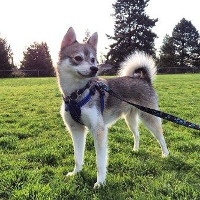Appearance of the Alaskan Klee Kai
|
| The Alaskan Klee Kai looks almost identical to its great ancestor, the Alaskan Husky. It can be found in any color except solid white. He has a distinctive face mask that gives him an inquisitive look. He has a double coat that will shed continuously throughout the year. His topcoat is straight and hard to the touch, weather-resistant, while his undercoat is lighter in color and soft. His eyes are round and dark brown, although he may have amber or blue eyes. It has a broad black nose with open nostrils. The Alaskan Klee Kai comes in three distinct sizes : toy, miniature and standard. The toy variety stands 33 centimeters at the shoulder and weighs less than 4.5 kilos. The miniature variety measures over 33 centimetres but no more than 38 centimetres at the shoulder, and weighs between 4.5 and 6.8 kilos. The standard Alaskan Klee Kai measures between 40.5 and 43 centimetres at the shoulder and weighs between 6.8 and 10.5 kilos. |
Temperament of the Alaskan Klee Kai
|
| Although directly descended from the Siberian and Alaskan Husky, the Alaskan Klee Kai was not bred to be a true working dog. He was bred strictly as a pet. He is naturally shy with strangers and will avoid them whenever possible. Many people characterize him as nervous. He is very devoted to his family and makes an excellent watchdog for the home. The Alaskan Klee Kai is a very vocal dog, making its wishes known through vocalization. Although his small size is perfect for apartment living, if his family ignores him most of the day, he can become a nuisance to neighbors with his barking and whining. He needs daily walks and time with his family. It's best for him to run and play in a fenced-in yard, but he can also enjoy long daily walks. Training and socialization should be undertaken from an early age to prevent his agility from becoming something more troublesome, and him from becoming an adjusted member of the family. |
Needs and activities of the Alaskan Klee Kai
|
| Never trust the Alaskan Klee Kai, even when you think he's perfectly trained. He can be a stubborn dog and needs a long leash or fenced yard to run and play without the temptation to take off after something interesting. He's a small dog, but he's also a fast one. He's an active little dog and needs plenty of time to play and enjoy his family. A good way to strengthen the bond between owner and Alaskan Klee Kai is to train together in dog sports. The Alaskan Klee Kai is an excellent candidate for agility, rally or even flyball. |
Maintenance of the Alaskan Klee Kai
|
| The Alaskan Klee Kai is not a hypoallergenic breed. It has a thick double coat that throws constantly. He's also a seasonal thrower and will take on heavy chores twice a year. For a small dog, he has a lot of hair when he sheds a lot. His grooming needs are generally minimal. Brush him thoroughly once a week with a comb, smooth bristle brush and brush to remove loose hair. He'll need brushing every day as he sheds more hair, and warm baths will help loosen the coat and speed up the shedding process. Don't bathe your Alaskan Klee Kai too much - he doesn't have a strong dog smell and should only be bathed twice a year, or only when he gets into mud or other unpleasant substances. Because he's an active dog, he may naturally wear out his nails, but check them at least every two weeks to make sure they don't need a quick trim. Have his teeth professionally cleaned once a year to maintain good oral hygiene. |







 English (United Kingdom)
English (United Kingdom)